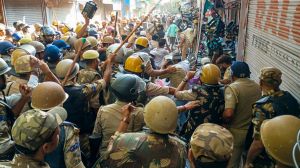So 19th Century
RESTORATION architect Vikas Dilawari has a spiral notebook; in it he jots down the features, problems and highlights of his projects. Almost...

RESTORATION architect Vikas Dilawari has a spiral notebook; in it he jots down the features, problems and highlights of his projects. Almost in the middle of the dog-eared diary is a note about his latest assignment: ‘‘Finest interiors of any 19th century building’’. The reference is to the Victorian interiors of the country’s second oldest museum, Mumbai’s Dr Bhau Daji Lad—awardee of the 2005 Award of Excellence in the UNESCO Asia-Pacific Heritage Awards for a Culture Heritage Conservation programme. It is one of just two Indian sites to get a UNESCO citation this year.
‘‘That’s not my line, it’s in the thesis of architectural historian Dr Christopher London,’’ says 40-year-old Dilawari. Till recently, it would have been very difficult to imagine its interiors in any form other than its post-Independence government office-like avatar, when the 133-year-old museum’s grandiose iron pillars, its grand central archway, the classic gilt work—everything was painted a standard cream colour. The windows were grilled, the bathrooms reeked and the museum’s priceless collection, including Charles Watson’s assortment of fabric samples and 4,000 coins, was thrown about in a layout fashioned along the lines of an obstacle course.
That’s when the optimistic imagination of Tasneem Mehta and her team at the Indian National Trust for Art and Cultural Heritage (INTACH) came round. ‘‘In 1996, we came to see this museum as a possible option where we could make a conservation lab. It was derelict but it was easy to see how wonderful it must have been,’’ says Mehta.
Designed by municipal engineer William Tracey and completed by Scott McClellant and co., the museum opened as the Victoria and Albert Museum (the name was changed to Bhau Daji Lad in 1975) in 1872. It was built with contributions from the city’s most successful and benevolent businessmen as a testimonial to the life and times of the Bombay Presidency. The grand ambition was ‘‘science and art in the service of industry’’—an institution for organic learning and increasing trade awareness.
More than a century later, it took Mehta years of shuttlecock negotiations with sponsors and the bankrupt BrihanMumbai Municipal Corporation (BMC) to get the gold leaf back on. ‘‘It was karmic. It took a long time but our final sponsors approached us with an offer,’’ says Mehta. The final kitty was funded by the Jamnalal Bajaj Foundation and the BMC, making it a grand total of Rs 12 crore.
Despite the money in hand, trying to imagine a monochromatic room in Victorian technicolour requires a dangerous level of imagination. ‘‘We had almost nothing to go by, there were some old record books and a few black and white pictures,’’ says Mehta. The V&A museum in London invited Mehta and her team to tour Victorian museums in the UK to get an understanding of what the final product should look like.
The yellow’s gone. In its place, is a very Victorian Caledon green and magenta—the efforts of restoration experts Premier Constructions, and the gilt’s been pressed into place. ‘‘We’ve put in almost Rs 50 lakh worth of gold on the walls,’’ says Mehta.
In a sunlit room, left of the stairwell, 27-year-old Madhura Joshi and 28-year-old Anant Shelke quietly scrape the layers of neglect off the wooden statue of a soldier of the Punjab regiment. He’s one of 4,000 objects that make up the museum’s collection. Like a trade fair presentation, there are large tableaux of Bombay life and tradesmen, the costumes of different communities, old maps, 150 miniatures… the index runs on. ‘‘The collection was taken to Europe to show people what life in India was like. It was meant to increase trade with the colonies,’’ says Mehta.
Decades ago, it taught the Europeans a little bit about India, now the Bhau Daji Lad museum could teach us a little bit about ourselves.







- 01
- 02
- 03
- 04
- 05
























